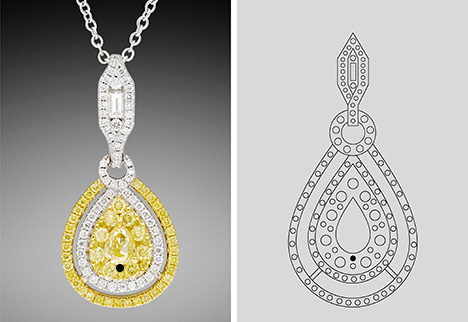HPHT Synthetic Diamond Melee in High-Quality Jewelry Piece

Advances in the laboratory growth of diamonds have led to an increase in the number of synthetic diamonds seen at GIA. The existence of high-quality synthetic diamonds in melee sizes is of particular concern. This is due in part to the expense of examining melee relative to their value. While GIA can reliably identify synthetic melee, this requires individual analysis of each stone, preferably before mounting. In a complicated piece with hundreds of melee, this can be prohibitively expensive or time-consuming. The same is true for melee parcels. A synthetic diamond mixed into a packet may not be identified until later, deceiving dealers, jewelers, and consumers and potentially causing damage to the trade.
Recently, a pendant with 118 mounted stones was submitted to GIA’s New York laboratory for color origin analysis of each individual melee (figure 1). The pendant consisted of a central pear-shaped stone surrounded by three consecutive rows of round brilliant melee. Of the 118 stones, 58 were fancy yellow, including the center stone, and 60 were colorless. Using a Fourier-transform infrared (FTIR) microscope in reflection mode allowed detailed focusing of the infrared beam on the mounted stones, including those that were partially obscured. Analysis was carried out on a Thermo Nicolet iN10 FTIR microscope, which determined the diamond type classification of each melee stone from its mid-IR absorption spectra (C.M. Breeding and J. E. Shigley, “The ‘type’ classification system of diamonds and its importance in gemology,” Summer 2009 G&G, pp. 96–111). One melee was identified as an HPHT-grown (high-pressure, high-temperature) synthetic diamond, based on its infrared spectrum as well as its color, fluorescence pattern, and phosphorescence behavior. This 0.00431 ct melee was removed from the setting to confirm its origin as HPHT-synthetic. The rest were confirmed as natural diamonds.
Of the 118 melee, 114 were classified as type IaA or type IaAB. These were characterized by absorption from aggregated nitrogen centers, where A-centers (nitrogen pairs) and B-centers (four nitrogen atoms symmetrically surrounding a vacant lattice site) absorb infrared light at 1282 and 1174 cm–1, respectively. These spectra revealed sufficient A-center concentrations, eliminating the possibility of HPHT treatment, which would have deaggregated the centers into isolated nitrogen atoms (A.T. Collins, “The colour of diamond and how it may be changed,” Journal of Gemmology, Vol. 27, No. 6, 2001, pp. 341–359). Since A- and B-center absorptions occur solely in the infrared range, their presence does not produce color. Instead, the yellow color observed in 57 of these type IaA/IaAB stones resulted from absorption from the N3 defect at 415 nm (a complex of three nitrogen atoms surrounding a vacancy) and associated peaks at 453, 452, 465, and 478 nm. This spectrum is known as the “Cape series,” and such goods are commonly referred to as “Cape yellow.”
Two colorless stones were classified as type IaB, showing only pure B-aggregate absorption; the remaining colorless stone was type IIa, meaning it did not show IR absorption from any nitrogen-related impurities. Finally, a partially obscured yellow stone near the bottom of the piece was type Ib, showing absorption due to isolated nitrogen impurities, and characterized by features at 1130 and 1344 cm–1. Isolated nitrogen centers also produce a broad absorption feature in the UV-visible range (approximately 270 nm), resulting in a coloration often described as “Canary yellow.” Type Ib diamonds are very rare, representing only 0.1% of all natural diamonds (R. Tappert and M.C. Tappert, Diamonds in Nature, Springer, Berlin, 2011). Conversely, this diamond type is common in yellow synthetic diamonds. Due to the absence of A-centers, these four samples required further testing.
Photoluminescence spectroscopy confirmed that the type IaB and IIa stones were natural in origin. However, the type Ib stone (marked in figure 16) was further examined with DiamondView imaging, which showed that it exhibited strong yellow-green fluorescence under deep ultraviolet illumination (wavelength 230 nm) and indicated growth sector patterns typical of HPHT synthetic diamonds, as well as strong blue phosphorescence inconsistent with natural yellow type Ib diamonds (J.E. Shigley et al., “A chart for the separation of natural and synthetic diamonds,” Winter 1995 G&G, pp. 256–264; J.E. Shigley et al., “Gemological properties of near-colorless synthetic diamonds,” Spring 1997 G&G, pp. 42–53). The 0.00431 ct yellow stone was removed from its mounting for more comprehensive examination with the DiamondView (figure 2). Its cuboctahedral synthetic growth sectors were clearly seen from both the table and pavilion, confirming its HPHT synthetic origin.

Although this could have been an isolated event, it underscores the need for caution when buying melee parcels or mounted pieces from unfamiliar sources. Nevertheless, it is important to note that such stones can be unequivocally identified as lab-grown. Colorless and near-colorless (D–N) unmounted diamonds larger than 0.01 ct can be tested using commercially available testing equipment such as the GIA DiamondCheck. Meanwhile, colored diamonds, smaller stones, and mounted jewelry need to be tested by a reputable gemological laboratory. Increased industry awareness, combined with diamond testing, may deter the spread of undisclosed synthetics, ultimately benefiting both sellers and buyers of polished diamond goods.
.jpg)


